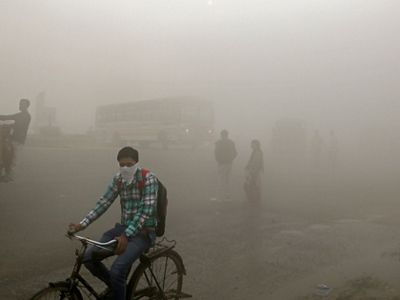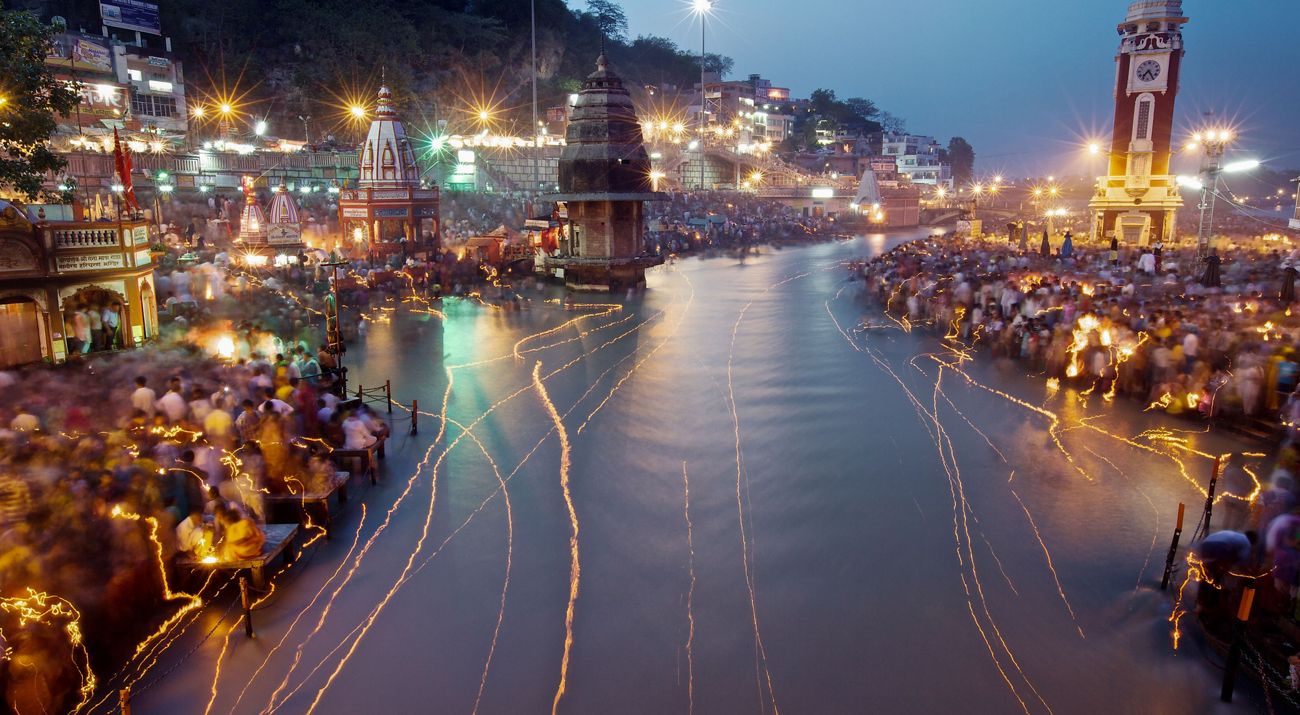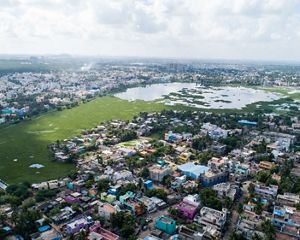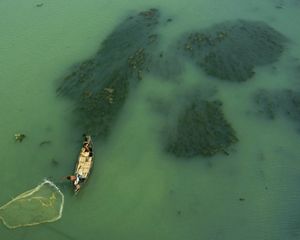India Rising
One of the planet's fastest-growing countries steps up to balance economic growth with nature.
Summer 2018
Narayanapuram Lake sits nearly lost amid urban growth on the fringe of Chennai, a sprawling city of more than 8 million people near the Bay of Bengal. Newly built apartment towers and concrete single-story homes crowd the lake’s edges, while waves of motor scooters, water tankers and trucks loaded with steel rebar rush by, all part of India’s cacophonous stampede into a more prosperous future.
A quarter century ago, the lake was surrounded by fields of rice. The berms between them were lined with distinctive Palmyra palms, which still help people discern the remnant outline of a much larger, interconnected water system. Narayanapuram is one of a series of 32 lakes that cascade into the Pallikaranai Marshland, the last remaining natural marshland in Chennai. These days it’s difficult to appreciate the system as a functioning ecological whole, once spanning almost 20,000 acres. Only 10 percent of the marsh remains.
Alpana Jain stands at the edge of the lake, her red pants-and-tunic outfit a vivid counterpoint to the dust and concrete. Jain manages urban projects for The Nature Conservancy’s newly inaugurated program in India. On the drive here, she noted the demise of another nearby lake, obliterated by new construction. “Now it’s gone,” she said. “It’s even vanished from the map.”
This January morning, Chennai is suffering from a drought, but there are visible hints of a different problem as well. On the eastern edge of the lake, a technicolor Hindu temple with jangling bells stands stubbornly sandbagged against past and future floodwaters. This is the reality of life in Chennai, a vicious whipsawing between not enough water and far too much. For Narayanapuram Lake, that harsh duality is compounded by additional insults. The lake and its marshes used to store rainwater and recharge the groundwater aquifer. Now, they absorb huge inflows of untreated sewage. And, with large portions of the lakes hemmed in and paved over, rainwater has nowhere to go but into people’s homes.
If you look closely enough, though, there are still signs of nature at Narayanapuram. Even today, migratory birds use the lake: glossy ibises, pheasant-tailed jacanas, painted storks and flamingos that wing their way here nearly 3,000 miles from Iran. “Despite all the trauma to the region,” Jain says, “there are still something like 122 species that use the lakes and marshland.”
Narayanapuram represents the story of more than 85 percent of Chennai’s wetlands, which have been degraded or lost due to rapid and unplanned urbanization. Jain is helping to launch a program that will restore Chennai’s lake system and the remaining marsh, which could offer hope not just for migratory birds and other wildlife, but for the people of Chennai as well. Now, TNC and its partners—Care Earth Trust and Indian Institute of Technology, Madras—are working closely together on a pilot project to show that a restored wetland system can help capture floods during heavy rains and replenish underground aquifers as a hedge against drought. The work here in Chennai is part of TNC’s broader program in India, which was officially launched in June 2017.
The country’s population rivals China’s, and the International Monetary Fund estimates that the two nations’ economies are growing at roughly the same breakneck rate. Protecting nature and keeping natural systems sustainable in the face of such overwhelming growth will be a huge challenge—but it could also be critical for sustaining momentum that is helping to pull millions out of poverty every year.
To demonstrate how India can continue to grow without sacrificing its biggest natural assets, TNC is launching a series of aggressive new projects to tackle problems in the air, water, lands and cities. “India is a country that is facing the challenges of people and nature,” says Seema Paul, TNC’s former managing director for India. “It has high economic growth. It has 1.3 billion people. It wants to be sustainable. How can TNC not be in India?”

India is growing at a speed and scale that is often difficult to reckon with. The country has about 16 percent of the world’s population, 8 percent of its biodiversity and about 2 percent of its land. It has the seventh-largest economy in the world, and vast numbers of its citizens are lifting themselves toward higher standards of living every year.
But all of this rapid change comes with problems. It’s estimated that some 600 million people will migrate to India’s cities by 2050, but many cities are developing without adequate planning. Farming is making the air unbreathable because of the widespread practice of burning crop residue, and groundwater pumping is depleting aquifers and taxing India’s strained electrical infrastructure. Energy demand nationwide is predicted to nearly double by 2050.
For environmental organizations, there is work to be done everywhere in India. In the face of such overwhelming need, TNC is trying to identify and respond to the most pressing challenges.
The Conservancy began evaluating the potential for working in India less than five years ago, determining how it might build on the work of existing nongovernmental organizations. While India has an abundance of such groups, many are relatively small and work quite close to the ground.
“When we developed our strategy for India, we looked at what TNC is, and what India needs,” says Paul. In a country with countless ideologically driven organizations—and an establishment that’s often skeptical of their motives—TNC stands out for its ability to conduct its own unbiased science to fill important knowledge gaps. “The role we can play here,” she says, “is one of an applied-science leader.”
Working with partners, TNC is developing demonstration projects addressing water security, air quality and renewable energy development throughout the country. By showing the feasibility of each concept, the team hopes to enlist the help of partners and the government to take the efforts to a much bigger scale.
“The culture here [at TNC India] is more like a start-up,” says Sushil Saigal, who oversees TNC’s lands program in India.
Of all the environmental problems bedeviling India, air pollution has received the most recent international attention. The World Health Organization calculates that 1.4 million Indians die prematurely every year because of air pollution, more than anywhere else in the world. But the eye-watering price of economic progress is nowhere more evident than in New Delhi. There, more than 19 million people suffer through a now-annual wintertime “airpocalypse” that routinely closes schools, sends children to intensive-care units and smothers the city with an all-pervading stench.
The toxic haze consists of diesel and industrial exhaust, as well as wood and trash burned for wintertime heating. But fully a quarter of the problem stems from farmers in the neighboring states of Haryana, Punjab and Uttar Pradesh burning rice stubble in preparation for the wintertime wheat crop. The government has responded with a ban on burning crop residue, but farmers have mostly ignored it because they have only a few weeks to switch their fields from rice to wheat.
To tackle that challenge, TNC—in partnership with The International Maize and Wheat Improvement Centre, the Borlaug Institute for South Asia, and the Council on Energy, Environment and Water—is pulling together a plan centered on a locally produced farm implement called the Happy Seeder. The apparatus, which can be hitched to the back of a tractor, chops and spreads the rice stubble over the field while simultaneously planting wheat seeds. The mulch it produces preserves valuable soil moisture and also serves as free fertilizer, while completely eliminating farmers’ need to burn their fields.
Roughly 2,000 Happy Seeders are currently in operation in Punjab and Haryana, but TNC and its partners hope to help farmers put a total of 50,000 of them into use over the next five years—an effort that would run somewhere in the neighborhood of $120 million. Early this year, India’s government announced that it would subsidize up to half the cost of a Happy Seeder for individual farmers, and 80 percent of the cost for farmer cooperatives.
The partner organizations are now working to launch a large-scale awareness program among farmers. If the partnership can get those seeders into the fields of northwest India, it would mean healthier soil, better crops and 8.4 million acres that no longer need to be burned.

On a rocky, tree-dotted ridgeline in central India, Dhaval Negandhi, a TNC ecological economist, watches dozens of wind turbines slowly spin in the breeze as a Bollywood song wafts up from a nearby village. The wind farm here offers a glimpse of India’s energy future.
According to government figures, some 300 million Indians still lack access to electricity. The government is racing to close that gap, creating demand for more power sources. At the same time, India has committed to achieving two ambitious climate goals by 2030: have 40 percent of its electrical generation capacity based on renewable resources, and create carbon sinks to sequester another 2.5 to 3 billion tons of carbon dioxide. By 2022, the state of Madhya Pradesh, where this wind farm is located, and neighboring Maharashtra plan to nearly triple their combined renewable energy capacity, to 34 gigawatts. That will include at least seven “mega” solar power projects, averaging about 640 megawatts each.
That will be good for the climate. But renewable energy projects, when badly planned, can destroy large areas of habitat. Each megawatt of solar energy, for example, typically requires roughly 10 to 12 acres of land. Add up all of India’s potential renewable energy projects and they could have a huge impact on natural habitats.
This wind farm, about 80 miles from the city of Bhopal, hints at the problem: It is built on former forestlands technically under protection by Madhya Pradesh.
To protect farms, Negandhi says, government policies make it very difficult for developers to get access to agricultural lands. Forestland, meanwhile, is comparatively easy to build on. That’s a problem. Here, the bulldozed clearings for the wind towers plus dozens of miles of new access roads, totaling roughly 500 acres, have undercut India’s carbon-sequestration efforts and fragmented the forest.
Central India is also an important landscape for the Bengal tiger, an animal loaded with iconic significance. Since the 1970s, India has brought tiger populations back from less than 1,000 to about 2,300 today—more than half of the world’s total. And tigers ecologically represent something much more than themselves. “The tiger is an umbrella species,” says Negandhi. “Because it has a very large home range, when you protect the tiger, you end up protecting a large number of species that share that habitat.” Despite India’s high population density, it still supports high biodiversity and relatively healthy populations of large mammals in close quarters to humans.
Negandhi is focused on finding a balanced path for future renewable energy development. The Conservancy wants to see new installations prioritized on property that has already been disturbed—for example, siting wind turbines near farm fields or solar panels on rooftops—rather than clearing wildland. “There is so much land available that you can easily achieve 10 times your target [without degrading land],” he says. “It’s just a matter of planning.” The key, he adds, is to move beyond working project by project and helping decision-makers identify where new energy development will cause the least disruption to nature.
The Conservancy is adapting its existing energy siting programs for India. It is collaborating with the Bangalore-based Center for Study of Science, Technology and Policy, which is modifying an energy-planning tool called Darpan (“mirror” in Hindi). The program aims to facilitate win-win situations where developers and decision-makers can reach their renewable energy goals without building new projects in ecologically and socially sensitive areas—and even reduce delays in the permitting process.
“We need to get this conversation going, and quickly,” says Gaurav Kapoor, a principal research scientist with the center. “Because at the rate that renewable energy development is happening, it might be too late in a few years to then think about conservation.”
Quote: Seema Paul
India is a country that is facing the challenges of people and nature. How can TNC not be in India?
Back in Chennai, Alpana Jain and her colleagues from TNC are busy working with Indian nonprofits, educational institutions and the government to build a broader coalition for lake restoration. Krishna Mohan advises the Chennai municipal government as chief resilience officer. “The floods brought people together,” he says. But, he adds, after surviving the recent crisis of floods and drought, Chennai’s citizens need to rally together for longer-term wetland restoration. “It’s not enough to just come together during times of need. We need to do it in normal times as well.”
Hoping to ride a new wave of public awareness, TNC has drawn up a master plan for lake and wetland restoration in Chennai and is helping implement a proof-of-concept demonstration at Sembakkam Lake, just upstream from Narayanapuram. Jayshree Vencatesan is the head of Care Earth Trust, a Chennai-based organization partnering with TNC here. Vencatesan has a simultaneously warm and formidable bearing, and for nearly two decades she has been an untiring advocate for the wetlands.
“You need tenacity and you need patience,” she says. “Things don’t work at the pace you want them to work.”
This spring, Care Earth Trust began desilting the lake, clearing it of garbage and debris, removing invasive species and planting native grasses. Ongoing work will clear the lake’s inlet and outlet channels and create “buffer zones” of riparian vegetation and wetlands between the lake and its urban surroundings. The Conservancy is working with the government to install better water infrastructure that will keep sewage out of the lake, and has plans to fund the construction of artificial wetlands that will filter and clean sewage from the wastewater of local homes before it drains into the lake.
Over the next decade, TNC aims to expand restoration efforts at six to eight lakes in the area. The hope is that such investment will catalyze a larger, government-led effort to scale up restoration throughout Chennai—where roughly 200 lakes might still be saved—and beyond.
“It’s going to be a tough project. But,” Vencatesan adds with a firm smile, “it’s doable.”



